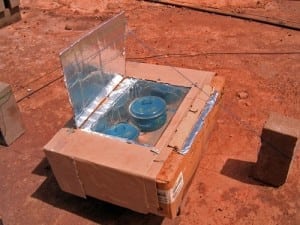Appropriate, DIY solar technology how-to guides are proliferating online. Junk-salvaging inventors have posted hundreds of videos and schematics to show cheap, simple ways to charge batteries and cook food using solar power. We’ve rounded up some of the most innovative video guides on our YouTube channel as well as tips for how to implement these ideas across cultures.
DIY pizza-box ovens – do they work?
For decades people have proposed solar ovens as a green alternative to the wood fires that cook meals in much of Sub-Saharan Africa and elsewhere. Collecting the wood exacerbates deforestation and trees are becoming scarce in some areas. Solar ovens seem like a good idea, if they are made cheaply and out of materials at hand.
The ovens reflect sunlight into a closed, insulated container and can pasteurize, even boil water and cook food. The pizza-box solar oven is easy to make from common materials and reportedly heats up to 225 degrees F. Even without technical skill, anyone can make one out of a pizza box, aluminum foil, newspaper for insulation, black paint or paper and plastic wrap. Instructional home videos abound, but How-Cast’s version is better-produced than most.
But do they work? YouTube’s “solarcookingnut” settles the question in a four-video series of tips to make the pizza-box cooker as efficient as possible.
A low-tech, sun-tracking solar barbecue
Brian White, a stone mason in Vancouver, Canada, has made some clever innovations on the solar oven design. As “Gaiatechnician,” He has posted dozens of videos and how-to guides on YouTube for making a low-tech sun-tracking oven. His designs incorporate mud and parts he scrounges from his yard – such as desk legs and a discarded road sign.
He invented a hand-held device made of wood blocks and a curtain rod that, like a glorified drafting compass, plots parabolic curves. Using the “mechanical mathematician,” as he calls it, even people with little technical skill can make parabolic reflectors for their solar ovens. He explains how to mount the oven on a rod and align it with the sun according to the season and the hemisphere. The oven is linked to a slowly leaking bucket of water, called a dripper tracker. As the bucket becomes lighter, the oven turns on its axis throughout the day, following the sun.
White’s designs are strictly appropriate technology and experimental – not flawless. For example, he wrote in an e-mail, “I ran into problems with seasonal adjustment because it changed the center of gravity of the thing, which in turn affected my dripper tracker. After all I made it from scraps.” He plans to make a new oven driven by larger water containers and salvaged parts from a clock, perhaps with a new reflector design that is better-balanced while it moves, he said. We’ve gathered some of his instructional videos on our channel.
DIY solar electricity
Instructions for true DIY solar electricity generators are perhaps beyond the scope of YouTube, but one British inventor proposes using ready-made parts for cheap solar power. Graham Knight’s video gives a glimpse of how to make a cell-phone or laptop battery charger from pieces of solar panels left over from commercial production, called off-cut panels. He sends free kits to people living in the developing world; details are available on his site.
Making it is the easy part
It’s one thing to make a solar oven, it’s another to get someone to use it. “Solar cookers have been offered for decades and still few villages take them up,” Knight wrote in an e-mail. Helping them catch on requires a commitment to work with a community for at least a year. And that still may not be enough, he said. “Even after 16 years with this project, I’m constantly mystified.”.
Fortunately, others who have navigated foreign cultures are not shy about sharing their advice online. , sums up his message as: “The most important, moving part in solar cooking is the cook who gains the benefits,”
“The cookers don’t matter unless they are used,” explained Ramon Coyle, who worked for the non-profit Solar Cookers International during the first half of this decade.. . And they won’t be used unless their advantages are clear. Coyle wrote an essay that was published on SCI’s archive site solarcooking.org about introducing new technology after hearing complaints from people who donated solar ovens to communities in developing countries and later discovered they were never used. “Some folks want to introduce solar cooking while traveling somewhere,” but he discourages that, he said.
“In international development, as in various other fields, what matters most is commitment. Everything will take longer than expected, and many plans will go awry,” he warned. But relationships and conversations about a community’s needs should get results, he said.
Resources:
- E4C YouTube channel
- Solar Cooking Archive Wiki
- Instructables sun-tracking oven instructions


